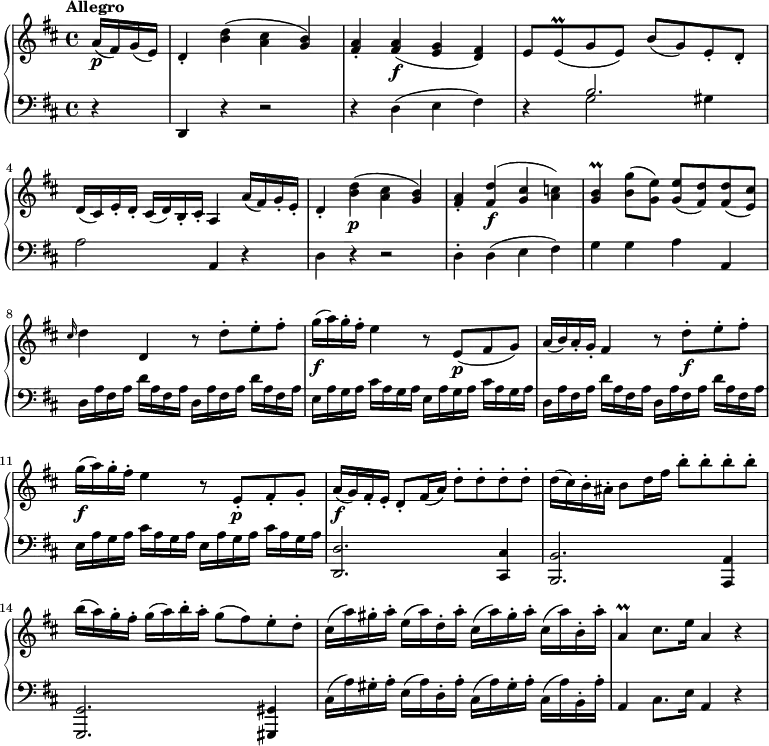| Three Piano Sonatas | |
|---|---|
| by Ludwig van Beethoven | |
| Catalogue | WoO 47 |
| Style | Classical period |
| Composed | 1782–1783 |
| Dedication | Maximilian Friedrich |
| Published | 1783 |
| Movements | Three each |
The Three Piano Sonatas, WoO 47, were composed by Ludwig van Beethoven probably in 1783, when he was twelve years old.[1] The sonatas show a certain level of precocity and serve as a precursor to the masterworks he later produced. They are dedicated to the Prince-elector (German: Kurfürst) Maximilian Friedrich[2] and therefore also known as the Kurfürstensonaten.
Overview
Like Mozart's, Beethoven's musical talent was recognized at a young age,[3] and these three piano sonatas give an early glimpse of the composer's abilities, as well as his boldness. Beethoven was writing in a form usually attempted by older, more mature composers,[4] as the sonata was a cornerstone of Classical piano literature. Since they were written at such an early age (and Beethoven himself did not assign them opus numbers), the works have historically been omitted from the canon of Beethoven's piano sonatas. However, Barry Cooper included the trio in his critical edition of the sonatas created for ABRSM, arguing that "A complete edition has to be complete, and if you ignore early works, you don't show the longer trajectory of the composer's development."[5] The inclusion of these three works raises Beethoven's total number of piano sonatas from 32 to 35.[lower-alpha 1][6]
The sonatas
No. 1 in E♭ major

- Beginning of No. 1 in E♭ major
No. 2 in F minor
![{
\new PianoStaff <<
\new Staff \relative c'' { \clef treble
\key aes \major
\tempo "Largetto Maestoso" 4 = 60
\set Score.tempoHideNote = ##t
\time 2/2
|
<f,\f aes c f>2\arpeggio
f8.\prall f16 f4
|
f8\p( aes) aes-. aes-.
aes\prall( g) g( f)
|
<<c'2\f e2 g2 c2>>
c,8.\prall c16 c4
|
g8(\p bes8) bes8-. bes-.
bes( aes) aes( g)
|
<<f2\ff f'2>>
r8
<<f,8-.\p f'8>>
<<f,8-. f'8>>
<<f,8-. f'8>>
|
<<f,8( f'8>>
<<ges,8) ges'8>>
<<ges,4\f ges'4>>
r8
<<ges,8-.\p ges'8>>
<<ges,8-. ges'8>>
<<ges,8-. ges'8>>
|
<<ges,8( ges'8>>
<<a,8) a'8>>
<<a,4\f a'4>>
r8
<<a,8-.\p a'8>>
<<a,8-. a'8>>
<<a,8-. a'8>>
|
<<bes,8\pp bes'8>>
<<f8 f'8>>
<<des,8 des'8>>
<<bes,8 bes'8>>
<<f,8 f'8>>
\hideNotes
r4.
|
r1
\unHideNotes
}
\new Staff \relative c { \clef bass
\key aes \major
|
<<f,2 f'2>>
<<f8. aes8.>>
<<f16 aes16>>
<<f4 aes4>>
|
<<\new Voice{\voiceTwo
f1
}
\new Voice{\voiceOne
aes8(
c8)
c8-.
c8-.
c8(
bes8)
bes8(
aes8)
}>>
|
<<c,2 e2 g2 c2>>
c,8.
c16
c4
|
\clef treble
<<\new Voice{\voiceTwo
c'1
}
\new Voice{\voiceOne
e8(
g8)
g8-. g8-.
g8( f8)
f8( e8)
}>>
|
\clef bass
aes,,,16 f'16 e16 f16
aes16 f16 e16 f16
aes,16 f'16 e16 f16
aes16 f16 e16 f16
|
bes,16 bes'16 a16 bes
des bes a bes
bes, bes' a bes
des bes a bes
|
c, c' b c
ees c b c
c, c' b c
ees c b c
|
<<\new Voice{\voiceTwo
<<des1 des,1>>
|
c2\fermata
c4
c4\rest
}
\new Voice{\voiceOne
\hideNotes
r2
r8
\unHideNotes
aes''8^[_( g8 <<f8] b8)>>
|
<<f2 b2\fermata>>
<<c4 g4 e4>>
aes4\rest
}>>
|
}>>
}](../I/276ca3ced20e3976b4661a76a8034b46.png.webp)
- Beginning of No. 2 in F minor
No. 3 in D major
- Allegro
- Menuetto – Sostenuto
- Scherzando: Allegretto, ma non troppo

- Beginning of No. 3 in D major
See also
References
Notes
- ↑ With the incipit of a possible 36th identified by Thayer.
Citations
- ↑ Cooper 2017, p. 15.
- ↑ Thayer 1921, pp. 71–74.
- ↑ Thayer 1921, p. 59.
- ↑ Cooper, Barry (2008). Beethoven (2nd ed.). Oxford University Press. p. 10.
- ↑ White, Michael (2008-01-20). "Settling Old Scores by Beethoven". The New York Times. Retrieved 2019-03-12.
- ↑ Cooper 2017, p. 13.
Sources
- Cooper, Barry (2017). The Creation of Beethoven's 35 Piano Sonatas. Routledge. ISBN 978-1-4724-1432-8.
- Thayer, A. W. (1921). Krehbiel, Henry Edward (ed.). The Life of Ludwig Van Beethoven, Vol 1. The Beethoven Association. OCLC 422583.
Further reading
- Song, Moo Kyoung (2002). The Evolution of Sonata-Form Design in Ludwig van Beethoven's Early Piano Sonatas, WoO 47 to Opus 22 (PDF) (Ph. D. thesis). University of Texas at Austin.